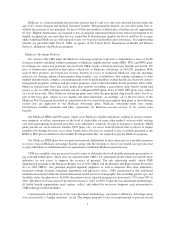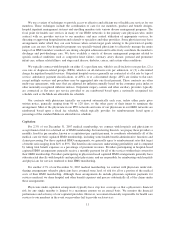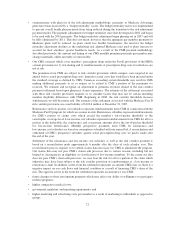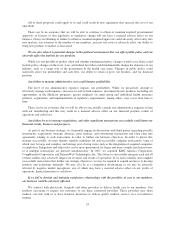Humana 2007 Annual Report Download - page 24
Download and view the complete annual report
Please find page 24 of the 2007 Humana annual report below. You can navigate through the pages in the report by either clicking on the pages listed below, or by using the keyword search tool below to find specific information within the annual report.premiums, and make payroll deductions for any premiums payable by the employees. We attempt to become an
employer’s or group’s exclusive source of health insurance benefits by offering a variety of HMO, PPO, and
specialty products that provide cost-effective quality health care coverage consistent with the needs and
expectations of their employees or members. We also offer commercial health insurance and specialty products
directly to individuals.
At December 31, 2007, we used licensed independent brokers and agents and approximately 700 licensed
employees to sell our commercial products. Many of our employer group customers are represented by insurance
brokers and consultants who assist these groups in the design and purchase of health care products. We generally
pay brokers a commission based on premiums, with commissions varying by market and premium volume. In
addition to a commission based directly on premium volume for sales to particular customers, we also have
programs that pay brokers and agents based on other metrics. These include commission bonuses based on sales
that attain certain levels or involve particular products. We also pay additional commissions based on aggregate
volumes of sales involving multiple customers.
Risk Management
Through the use of internally developed underwriting criteria, we determine the risk we are willing to
assume and the amount of premium to charge for our commercial products. In most instances, employer and
other groups must meet our underwriting standards in order to qualify to contract with us for coverage. Small
group laws in some states have imposed regulations which provide for guaranteed issue of certain health
insurance products and prescribe certain limitations on the variation in rates charged based upon assessment of
health conditions.
Underwriting techniques are not employed in connection with our Medicare, military services, or Medicaid
products because government regulations require us to accept all eligible applicants regardless of their health or
prior medical history.
Competition
The health benefits industry is highly competitive. Our competitors vary by local market and include other
managed care companies, national insurance companies, and other HMOs and PPOs, including HMOs and PPOs
owned by Blue Cross/Blue Shield plans. Many of our competitors have larger memberships and/or greater
financial resources than our health plans in the markets in which we compete. Our ability to sell our products and
to retain customers may be influenced by such factors as those described on page 17 in Item 1A.—Risk Factors.
Government Regulation
Federal regulation
Government regulation of health care products and services is a changing area of law that varies from
jurisdiction to jurisdiction. Regulatory agencies generally have broad discretion to issue regulations and interpret
and enforce laws and rules. The passing of the Medicare Modernization Act of 2003, or MMA, represents the
most sweeping changes to Medicare since the BBA in 1997. Changes in applicable laws and regulations are
continually being considered, and the interpretation of existing laws and rules also may change periodically.
These regulatory revisions could affect our operations and financial results. Also, it may become increasingly
difficult to control medical costs if federal and state bodies continue to consider and enact significant and
sometimes onerous managed care laws and regulations.
State and local regulation
We are also subject to substantial regulation by the states in which we do business. We regularly are audited
and subject to various enforcement actions by state departments of insurance. These departments enforce laws
14
























